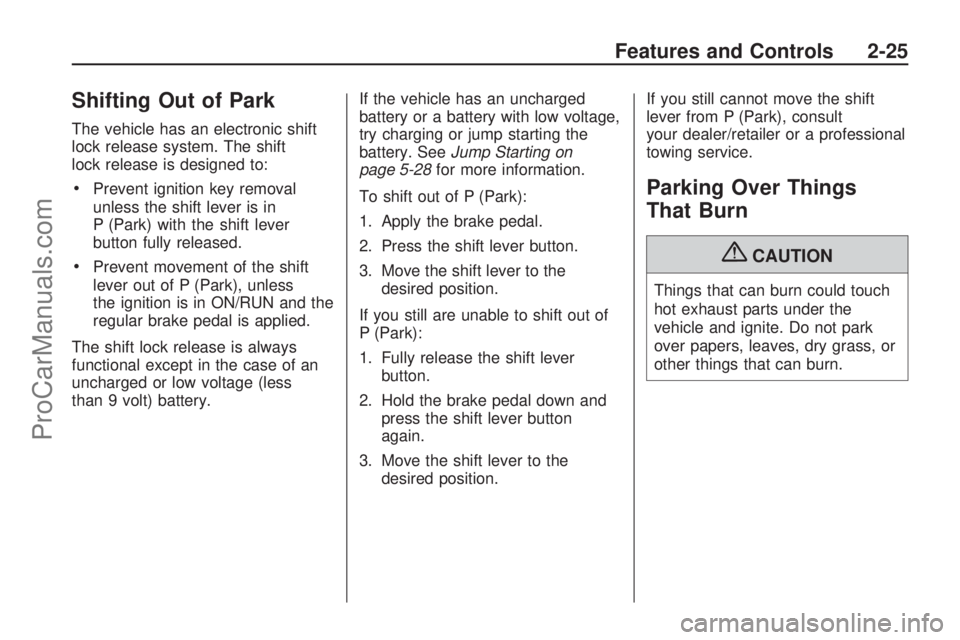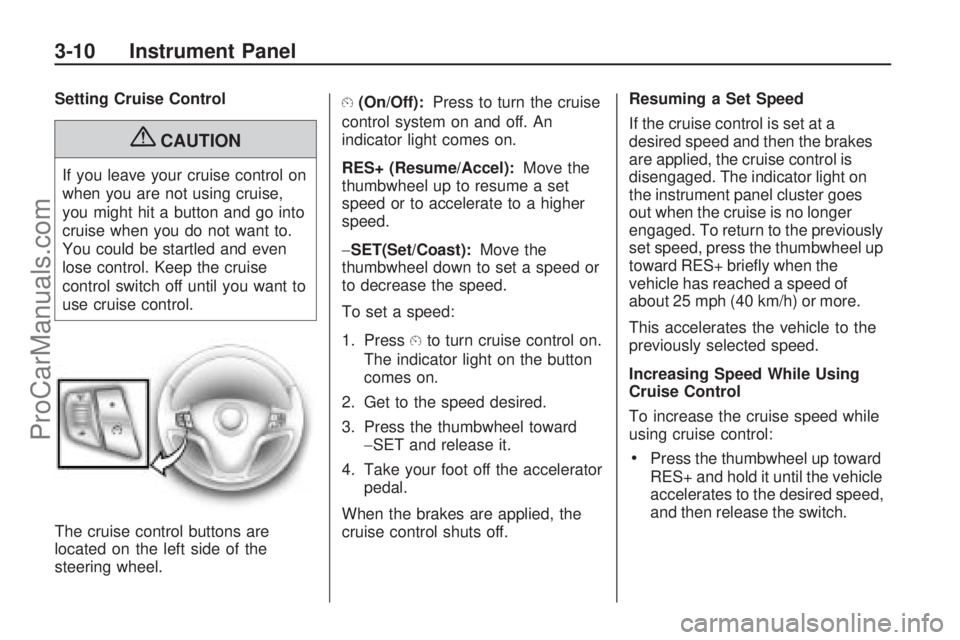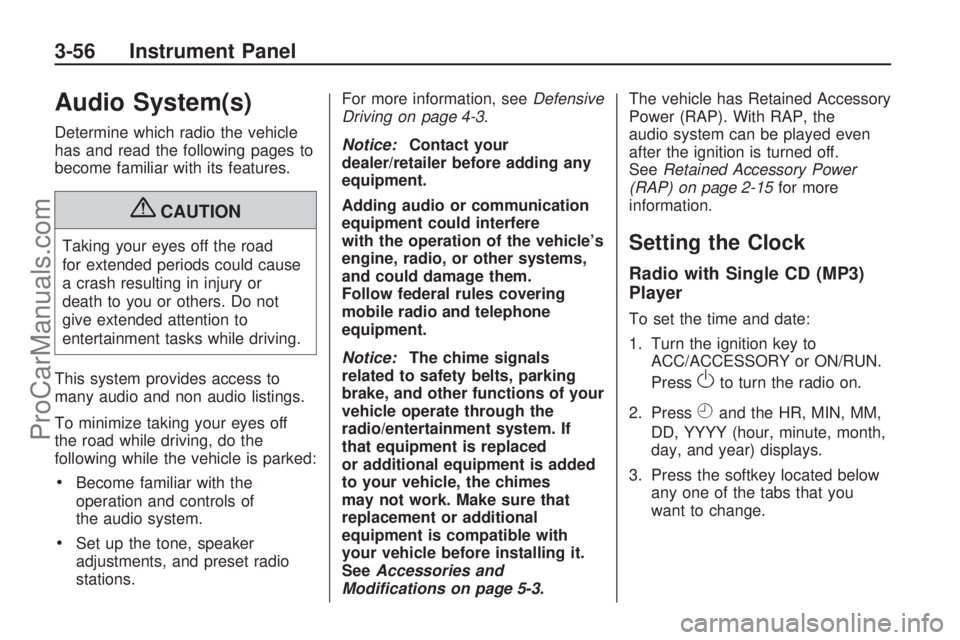brake SATURN VUE HYBRID 2009 User Guide
[x] Cancel search | Manufacturer: SATURN, Model Year: 2009, Model line: VUE HYBRID, Model: SATURN VUE HYBRID 2009Pages: 346, PDF Size: 2.1 MB
Page 87 of 346

Shifting Out of Park
The vehicle has an electronic shift
lock release system. The shift
lock release is designed to:
Prevent ignition key removal
unless the shift lever is in
P (Park) with the shift lever
button fully released.
Prevent movement of the shift
lever out of P (Park), unless
the ignition is in ON/RUN and the
regular brake pedal is applied.
The shift lock release is always
functional except in the case of an
uncharged or low voltage (less
than 9 volt) battery.If the vehicle has an uncharged
battery or a battery with low voltage,
try charging or jump starting the
battery. SeeJump Starting on
page 5-28for more information.
To shift out of P (Park):
1. Apply the brake pedal.
2. Press the shift lever button.
3. Move the shift lever to the
desired position.
If you still are unable to shift out of
P (Park):
1. Fully release the shift lever
button.
2. Hold the brake pedal down and
press the shift lever button
again.
3. Move the shift lever to the
desired position.If you still cannot move the shift
lever from P (Park), consult
your dealer/retailer or a professional
towing service.
Parking Over Things
That Burn
{CAUTION
Things that can burn could touch
hot exhaust parts under the
vehicle and ignite. Do not park
over papers, leaves, dry grass, or
other things that can burn.
Features and Controls 2-25
ProCarManuals.com
Page 88 of 346

Engine Exhaust
{CAUTION
Engine exhaust contains Carbon
Monoxide (CO) which cannot be
seen or smelled. Exposure to CO
can cause unconsciousness and
even death.
Exhaust may enter the vehicle if:
The vehicle idles in areas
with poor ventilation (parking
garages, tunnels, deep snow
that may block underbody
air�ow or tail pipes).
The exhaust smells or
sounds strange or different.
The exhaust system leaks
due to corrosion or damage.
The vehicle’s exhaust system
has been modi�ed, damaged
or improperly repaired.
(Continued)
CAUTION (Continued)
There are holes or openings
in the vehicle body from
damage or after-market
modi�cations that are not
completely sealed.
If unusual fumes are detected or if
it is suspected that exhaust is
coming into the vehicle:
Drive it only with the windows
completely down.
Have the vehicle repaired
immediately.
Never park the vehicle with the
engine running in an enclosed
area such as a garage or a
building that has no fresh air
ventilation.
Running the Vehicle
While Parked
It is better not to park with the
engine running. But if you ever have
to, here are some things to know.
{CAUTION
Exiting the vehicle, without �rst
shifting into P (Park), may cause
the vehicle to move, and you or
others can be seriously injured.
Because the vehicle has the
Automatic Engine Start/Stop
feature, the vehicle’s engine might
seem to be shut off when you
come to a complete stop.
However, once the brake pedal is
released, the vehicle can move.
The vehicle’s engine can also
restart at any time.
Shift to P (Park) and turn the
ignition to LOCK/OFF, before
exiting the vehicle.
2-26 Features and Controls
ProCarManuals.com
Page 103 of 346

Instrument Panel
Instrument Panel
Overview
Instrument Panel
Overview...........................3-4
Hazard Warning Flashers. . .3-5
Horn...................................3-5
Tilt Wheel...........................3-6
Turn Signal/Multifunction
Lever................................3-6
Turn and Lane-Change
Signals.............................3-6
Headlamp High/
Low-Beam Changer..........3-7
Flash-to-Pass......................3-7
Windshield Wipers..............3-7
Rainsense™ II Wipers........3-8
Windshield Washer.............3-8
Rear Window Wiper/
Washer.............................3-9
Cruise Control....................3-9
Exterior Lamps..................3-12
Wiper Activated
Headlamps......................3-12
Daytime Running
Lamps (DRL)..................3-13
Automatic Headlamp
System............................3-13
Instrument Panel
Brightness.......................3-14
Dome Lamp......................3-14
Entry Lighting....................3-14
Reading Lamps.................3-14
Electric Power
Management...................3-14
Battery Run-Down
Protection........................3-15
Accessory Power
Outlet(s)..........................3-16
Climate ControlsAutomatic Climate
Control System................3-17
Outlet Adjustment.............3-22
Warning Lights, Gages,
and Indicators
Warning Lights, Gages,
and Indicators.................3-22
Instrument Panel Cluster. . .3-23
Speedometer and
Odometer........................3-24
Trip Odometer..................3-24
Tachometer.......................3-24
Safety Belt Reminders......3-24
Airbag Readiness Light.....3-25
Passenger Airbag Status
Indicator..........................3-26
Charging System Light......3-27
Brake System Warning
Light................................3-27
Antilock Brake System
(ABS) Warning Light.......3-28
StabiliTrak®/Traction
Control System (TCS)
Warning Light
..................3-28
Engine Coolant
Temperature Warning
Light
................................3-29
Instrument Panel 3-1
ProCarManuals.com
Page 112 of 346

Setting Cruise Control
{CAUTION
If you leave your cruise control on
when you are not using cruise,
you might hit a button and go into
cruise when you do not want to.
You could be startled and even
lose control. Keep the cruise
control switch off until you want to
use cruise control.
The cruise control buttons are
located on the left side of the
steering wheel.
E(On/Off):Press to turn the cruise
control system on and off. An
indicator light comes on.
RES+ (Resume/Accel):Move the
thumbwheel up to resume a set
speed or to accelerate to a higher
speed.
−SET(Set/Coast):Move the
thumbwheel down to set a speed or
to decrease the speed.
To set a speed:
1. Press
Eto turn cruise control on.
The indicator light on the button
comes on.
2. Get to the speed desired.
3. Press the thumbwheel toward
−SET and release it.
4. Take your foot off the accelerator
pedal.
When the brakes are applied, the
cruise control shuts off.Resuming a Set Speed
If the cruise control is set at a
desired speed and then the brakes
are applied, the cruise control is
disengaged. The indicator light on
the instrument panel cluster goes
out when the cruise is no longer
engaged. To return to the previously
set speed, press the thumbwheel up
toward RES+ brie�y when the
vehicle has reached a speed of
about 25 mph (40 km/h) or more.
This accelerates the vehicle to the
previously selected speed.
Increasing Speed While Using
Cruise Control
To increase the cruise speed while
using cruise control:
Press the thumbwheel up toward
RES+ and hold it until the vehicle
accelerates to the desired speed,
and then release the switch.
3-10 Instrument Panel
ProCarManuals.com
Page 113 of 346

To increase the speed in small
amounts, press the thumbwheel
up toward RES+ brie�y and then
release it. Each time this is done,
the vehicle goes about 1 mph
(1.6 km/h) faster.
Use the accelerator pedal to
reach the desired speed
and press the thumbwheel
towards−SET. The new desired
speed must be greater than
the previous set speed by
typically 5 mph.
Reducing Speed While Using
Cruise Control
If the cruise control system is
already engaged,
Push the thumbwheel toward
−SET and hold until the desired
lower speed is reached, then
release it.
To slow down in very small
amounts, push the thumbwheel
toward−SET brie�y. Each time
this is done, the vehicle goes
about 1 mph (1.6 km/h) slower.Passing Another Vehicle While
Using Cruise Control
Use the accelerator pedal to
increase the vehicle’s speed. When
you take your foot off the pedal,
the vehicle will slow down to
the previously set cruise control
speed.
Using Cruise Control on Hills
How well the cruise control works on
hills depends upon the vehicle’s
speed, load, and the steepness of
the hills. When going up steep
hills, you might have to step on the
accelerator pedal to maintain the
vehicle’s speed. When going
downhill, you might have to brake or
shift to a lower gear to maintain
the vehicle’s speed. For some
vehicles the transmission may
automatically downshift when going
down hills to help maintain the
vehicle’s speed. When the brakes
are applied the cruise control
shuts off.Ending Cruise Control
There are three ways to disengage
the cruise control:
Step lightly on the brake pedal or
clutch; when cruise control
disengages, the indicator light on
the instrument panel cluster
goes out.
PressEto turn off the cruise
control system.
Erasing Speed Memory
The cruise control set speed memory
is erased when the cruise control or
the ignition is turned off.
Instrument Panel 3-11
ProCarManuals.com
Page 129 of 346

{CAUTION
If the airbag readiness light ever
comes on and stays on, it means
that something may be wrong with
the airbag system. To help avoid
injury to yourself or others, have
the vehicle serviced right away.
SeeAirbag Readiness Light on
page 3-25for more information,
including important safety
information.
Charging System Light
The charging system light comes on
brie�y when the ignition is turned
on, but the engine is not running, as
a check to show the light is
working. It should go out when the
engine is started.If the light stays on, or comes on
while driving, there could be a
problem with the electrical charging
system. Have it checked by your
dealer/retailer. Driving while this light
is on could drain the battery.
If a short distance must be driven
with the light on, be sure to turn off
all accessories, such as the
radio and air conditioner.
Brake System Warning
Light
The brake indicator light should
come on brie�y as the engine
is started. If it does not come on
have the vehicle serviced by
your dealer/retailer.
When the ignition is on, the brake
system warning light comes on
when the parking brake is set. Thelight stays on if the parking brake
does not fully release. If it stays on
after the parking brake is fully
released, there is a brake problem.
Have the brake system inspected
immediately.
{CAUTION
The brake system might not be
working properly if the brake
system warning light is on. Driving
with the brake system warning
light on can lead to a crash. If the
light is still on after the vehicle
has been pulled off the road and
carefully stopped, have the
vehicle towed for service.
If the light comes on while driving, a
chime sounds. Pull off the road and
stop. The pedal might be harder to
push or go closer to the �oor. It might
also take longer to stop. If the light is
still on, have the vehicle towed for
service. SeeTowing Your Vehicle on
page 4-22.
United StatesCanada
Instrument Panel 3-27
ProCarManuals.com
Page 130 of 346

Antilock Brake System
(ABS) Warning Light
For vehicles with the Antilock Brake
System (ABS), this light should
come on brie�y as the engine
is started. If it does not come on
have the vehicle serviced by
your dealer/retailer.
If the ABS light stays on longer than
a few seconds after engine is
started, or comes on and stays on
while driving, try resetting the
system. To reset the system:
1. While driving, pull over when it is
safe to do so.
2. Place the vehicle in P (PARK).
3. Turn off the ignition.
4. Then restart the engine.If the ABS light remains on after
resetting the system or comes
on again while driving, the vehicle
needs service. If the ABS light is on,
but the regular brake system
warning light is not on, the antilock
brakes are not working properly,
but the regular brakes are still
functioning. Have the vehicle
serviced right away. If both brake
lights are on, the vehicle does
not have antilock brakes, and there
is a problem with the regular
brakes as well. Have the vehicle
towed for service. SeeTowing Your
Vehicle on page 4-22.
StabiliTrak®/Traction
Control System (TCS)
Warning Light
The Traction Control System
(TCS)/StabiliTrak®system warning
light comes on brie�y as the
engine is started.
If it does not, have the vehicle
serviced by your dealer/retailer. If
the system is working normally
the indicator lights go off.
This light �ashes while the Traction
Control System (TCS) and/or the
StabiliTrak system are working.
It also �ashes when the Antilock
Brake System (ABS) is activated.
If the light comes on and stays
on while driving there is a problem
with the Traction Control System
(TCS) or the StabiliTrak system. The
3-28 Instrument Panel
ProCarManuals.com
Page 148 of 346

REMOTE KEY LEARNING
COMPLETE
This message displays while
matching a Remote Keyless Entry
(RKE) transmitter to your vehicle.
See “MATCHING TRANSMITTERS
TO YOUR VEHICLE” under
Remote Keyless Entry (RKE)
System Operation on page 2-4and
DIC Operation and Displays on
page 3-36for more information.
REPLACE REMOTE KEY FOB
BATTERY
This message displays if a Remote
Keyless Entry (RKE) transmitter
battery is low. The battery needs to
be replaced in the transmitter.
See “Battery Replacement” under
Remote Keyless Entry (RKE)
System Operation on page 2-4.
SERVICE A/C
(Air Conditioning) SYSTEM
This message displays when there
is a problem detected in the air
conditioning system. Have the
vehicle serviced by your
dealer/retailer.
SERVICE AIR BAG
This message displays when there
is a problem with the airbag
system. Have your vehicle serviced
by your dealer/retailer immediately.
SeeAirbag Readiness Light on
page 3-25for more information.
SERVICE BRAKE SYSTEM
This message displays along with
the brake system warning light
if there is a problem with the brake
system or when the brake �uid
level is low. SeeBrake System
Warning Light on page 3-27. Have
the brake system serviced by
your dealer/retailer as soon as
possible.
SERVICE HILL START ASSIST
This message displays if there is
a problem with the hill start
assist function. Have your vehicle
serviced by your dealer/retailer.
SERVICE HYBRID SYSTEM
This message displays if the hybrid
components need to be serviced.
Have your vehicle serviced by your
dealer/retailer.
SERVICE POWER STEERING
This message displays if there
has been a problem detected with
the power steering. SeeSteering on
page 4-9for more information.
3-46 Instrument Panel
ProCarManuals.com
Page 158 of 346

Audio System(s)
Determine which radio the vehicle
has and read the following pages to
become familiar with its features.
{CAUTION
Taking your eyes off the road
for extended periods could cause
a crash resulting in injury or
death to you or others. Do not
give extended attention to
entertainment tasks while driving.
This system provides access to
many audio and non audio listings.
To minimize taking your eyes off
the road while driving, do the
following while the vehicle is parked:
Become familiar with the
operation and controls of
the audio system.
Set up the tone, speaker
adjustments, and preset radio
stations.For more information, seeDefensive
Driving on page 4-3.
Notice:Contact your
dealer/retailer before adding any
equipment.
Adding audio or communication
equipment could interfere
with the operation of the vehicle’s
engine, radio, or other systems,
and could damage them.
Follow federal rules covering
mobile radio and telephone
equipment.
Notice:The chime signals
related to safety belts, parking
brake, and other functions of your
vehicle operate through the
radio/entertainment system. If
that equipment is replaced
or additional equipment is added
to your vehicle, the chimes
may not work. Make sure that
replacement or additional
equipment is compatible with
your vehicle before installing it.
SeeAccessories and
Modifications on page 5-3.The vehicle has Retained Accessory
Power (RAP). With RAP, the
audio system can be played even
after the ignition is turned off.
SeeRetained Accessory Power
(RAP) on page 2-15for more
information.
Setting the Clock
Radio with Single CD (MP3)
Player
To set the time and date:
1. Turn the ignition key to
ACC/ACCESSORY or ON/RUN.
Press
Oto turn the radio on.
2. Press
Hand the HR, MIN, MM,
DD, YYYY (hour, minute, month,
day, and year) displays.
3. Press the softkey located below
any one of the tabs that you
want to change.
3-56 Instrument Panel
ProCarManuals.com
Page 187 of 346

Driving Your
Vehicle
Your Driving, the Road,
and the Vehicle
Driving Your Vehicle...........4-1
Driver Behavior...................4-2
Driving Environment............4-2
Vehicle Design...................4-2
Driving for Better Fuel
Economy...........................4-3
Defensive Driving................4-3
Drunk Driving.....................4-4
Control of a Vehicle............4-4
Braking...............................4-5
Antilock Brake
System (ABS)...................4-6
Braking in Emergencies......4-6
StabiliTrak®System............4-7
Traction Control
System (TCS)...................4-8
Steering..............................4-9
Off-Road Recovery............4-10
Passing.............................4-11
Loss of Control.................4-11
Driving at Night.................4-12
Driving in Rain and on
Wet Roads......................4-13
Before Leaving on a
Long Trip........................4-14
Highway Hypnosis.............4-14
Hill and Mountain
Roads.............................4-14
Winter Driving...................4-15
If Your Vehicle is Stuck
in Sand, Mud, Ice,
or Snow
...........................4-17
Rocking Your Vehicle to
Get It Out.......................4-17
Loading the Vehicle..........4-18
Towing
Towing Your Vehicle.........4-22
Recreational Vehicle
Towing............................4-23
Towing a Trailer................4-26
Your Driving, the
Road, and the Vehicle
Driving Your Vehicle
Whenever we drive, we are taking
on an important responsibility.
This is true for any motor
vehicle — passenger car, van,
truck, sport utility. Driver behavior,
the driving environment, and
the vehicle’s design all affect how
well a vehicle performs. But
statistics show that the most
important factor, by far, is how
we drive.
Knowing how these three factors
work together can help you
understand how your vehicle
handles and what you can do to
avoid many types of crashes,
including a rollover crash.
Driving Your Vehicle 4-1
ProCarManuals.com